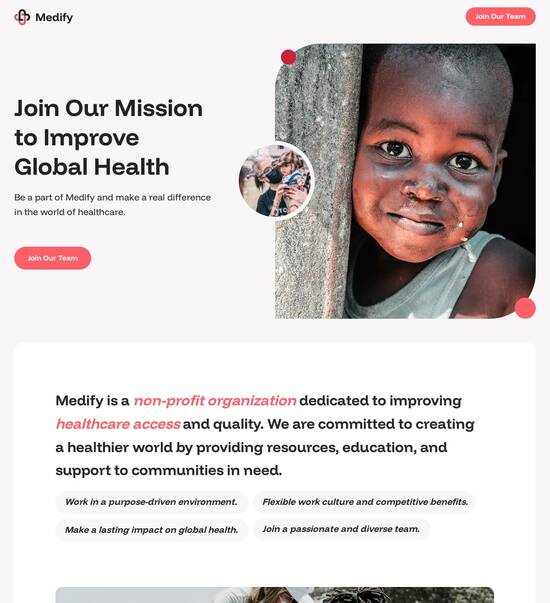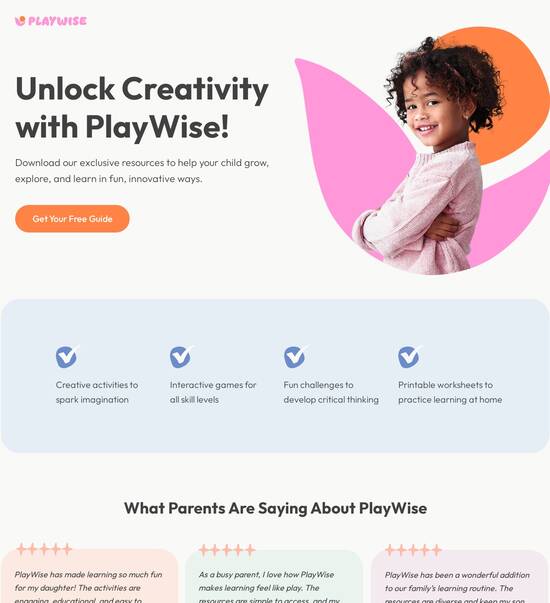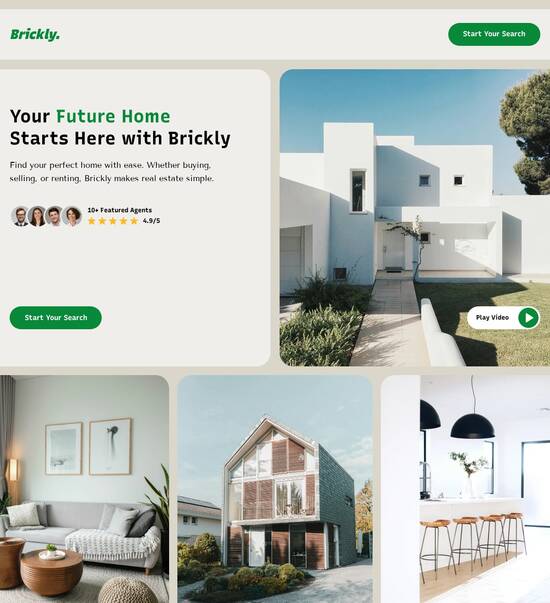
HTML page template for Mechanical engineers
Use TemplateAbout template
Attract clients and showcase your skills with style using our landing page templates for Mechanical engineers. Let's convert those visitors into clients!
Recommended templates

Easy to build without coding
With the intuitive drag-and-drop builder, anyone on your team can create high-converting pages without any knowledge of code or design. Make enhancements to your landing page with custom widgets using Javascript, HTML/CSS, or third-party scripts.

Multiple layouts for any industry and goal
Select from 500+ landing page layouts built to boost conversions across industry-specific scenarios. Customize them by adjusting fonts, adding images, and generating on-brand content with the AI assistant. Quickly scale with Instablocks® and Global Blocks that you can save, reuse, and update globally.

Loads fast and looks polished on any device
Every template is responsive, which means they present professionally on any device and load blazingly fast with our Thor Render Engine. You can also power them up with Google AMP technology to deliver an unparalleled mobile experience and drive higher conversions.

Robust analytics & experimentation
Get real-time updates and reporting across all your devices, showing the number of visitors, conversions, cost-per-visitor, and cost-per-lead. Launch AI-powered experiments, run A/B tests, and use heatmaps to analyze user behavior, then optimize your landing page to maximize conversions.







Easy to build without coding
With the intuitive drag-and-drop builder, anyone on your team can create high-converting pages without any knowledge of code or design. Make enhancements to your landing page with custom widgets using Javascript, HTML/CSS, or third-party scripts.
Multiple layouts for any industry and goal
Select from 500+ landing page layouts built to boost conversions across industry-specific scenarios. Customize them by adjusting fonts, adding images, and generating on-brand content with the AI assistant. Quickly scale with Instablocks® and Global Blocks that you can save, reuse, and update globally.
Loads fast and looks polished on any device
Every template is responsive, which means they present professionally on any device and load blazingly fast with our Thor Render Engine.
Robust analytics & experimentation
Get real-time updates and reporting across all your devices, showing the number of visitors, conversions, cost-per-visitor, and cost-per-lead. Launch AI-powered experiments, run A/B tests, and use heatmaps to analyze user behavior, then optimize your landing page to maximize conversions.
All the features you need to build lead-generating landing pages
Explore more featuresLearn how to build top-performing landing pages for any goal
FAQs
Leading the way in building high-performing landing pages





A step-by-step guide to mastering landing pages with Instapage
Instapage is the leading platform for creating high-converting landing pages designed to enhance your digital marketing strategies. With an extensive library of over 100 templates and powerful customization tools, marketers can quickly create and optimize landing pages that drive significant ROI. This guide will provide you with actionable steps to maximize your campaigns using Instapage's features.
Understanding landing page essentials
Landing pages are standalone web pages designed specifically for a marketing or advertising campaign. They direct visitors towards a single call to action (CTA). Instapage offers a range of customizable templates that empower marketers to build conversion-driven pages easily. It's crucial to focus on factors like design, messaging, and user experience when creating your pages.
- High-quality visuals: Ensure your landing page has engaging images and graphics to attract attention.
- Compelling headlines: Craft powerful headlines that clearly communicate the value proposition.
- Clear CTAs: Design noticeable buttons that direct users to take the desired action, such as signing up or making a purchase.
Step 1: Choose the right landing page template
Begin by selecting a suitable template from Instapage’s library. Various options cater to different industries, including business services and tech. Make sure to choose a layout that aligns with your campaign goals.
- Analyze your audience: Consider what your target demographic responds to when selecting your template.
- Test different designs: Utilize A/B testing to evaluate which templates perform better with your specific audience.
- Optimize for mobile: Ensure your chosen template is responsive and looks great on all devices.
Step 2: Personalize your landing page content
Tailoring your content is key to engaging potential customers. Use dynamic text replacement to ensure that your messaging resonates with specific audiences.
- Utilize AdMaps: Align ads with corresponding landing pages for a seamless user journey.
- Implement personalized CTAs: Different CTAs prompt action based on user behavior and preferences.
- Incorporate testimonials: Adding social proof can significantly boost conversions.
Step 3: Optimize for higher performance
Now that your landing page is set up, utilize Instapage’s optimization tools to enhance your conversion rates. Conduct A/B tests to determine what elements work best.
- Use heatmaps: Analyze user behavior on your page to identify what captures attention.
- Monitor metrics: Leverage the analytics dashboard to track performance and optimize accordingly.
- Iterate based on feedback: Regularly update your page based on user interactions and conversion data.
In conclusion, leveraging Instapage's powerful tools and features can significantly enhance your marketing efforts. By following these steps, you’ll create landing pages that not only attract but also convert visitors effectively.
Ready to elevate your marketing strategy? Start using Instapage today to create impactful landing pages and boost your ROI!
HTML page templates for mechanical engineers
Overview of HTML page templates for mechanical engineers
HTML page templates serve as a foundational framework that mechanical engineers can utilize to create web pages dedicated to their projects, research, or professional profiles. These templates streamline the process of web development, enabling users to focus on their content without getting mired in intricate coding details. As professionals in a technically demanding field, mechanical engineers benefit from having an established structure that enhances their online presence.
Customization is particularly crucial in mechanical engineering, where specific needs and standards often dictate content presentation. A tailored HTML template allows engineers to present their work accurately and attractively, reflecting their unique methodologies and findings while maintaining adherence to industry standards. In both academic circles and corporate environments, a well-structured template can align with branding and project requirements, ensuring communication is clear and effective.
Furthermore, HTML templates play a significant role in academic and professional settings. They can serve as a repository for research publications, case studies, or project showcases, ensuring that vital technical information is both accessible and engaging. Mechanical engineers are increasingly leaning towards online platforms for sharing their work and establishing connections. Thus, a solid HTML template becomes instrumental in navigating the digital landscape.
Key features of HTML page templates
When selecting an HTML page template, it is essential to consider key features that cater to the unique requirements of mechanical engineers. One crucial feature is responsive design capabilities. This aspect ensures that web pages are fully functional and aesthetically pleasing on devices of all sizes. With the growing use of mobile devices, templates that incorporate fluid grid systems and media queries are vital. They allow content to adapt effortlessly, providing a seamless user experience across smartphones, tablets, and desktops.
Another important element is built-in CSS styles. Predefined classes can enhance aesthetics significantly, allowing engineers to maintain a consistent theme. This consistency not only improves the overall professionalism of the presentation but also enhances readability, guiding viewers through complex technical content without confusion.
Additionally, interactive elements such as JavaScript integration augment template functionality. Incorporating libraries that accommodate rendered simulations can make it easier to display complex mechanical processes or models. Proper structure and organization through effective layouts division and use of grids enhance the clarity of technical content. All these aspects combined contribute to creating a user-friendly interface, which is paramount in delivering knowledge effectively.
Essential elements for mechanical engineers
For mechanical engineers, there are certain essential elements that must be integrated into HTML templates for effective communication of technical information. The presentation of technical documents, including research papers and case studies, is vital. This involves formatting content to allow for the clear display of intricate details, complete with sections for abstract, methodology, results, and discussions. Additionally, embedding technical diagrams and CAD models is crucial for contextual understanding, enabling viewers to visualize designs and concepts precisely.
Data visualization techniques also have a significant role in effective communication. Utilizing charts and graphs to represent data provides audiences with visual cues that aid in comprehension. Moreover, incorporating animations that demonstrate mechanical processes can facilitate a better grasp of technical mechanisms. Such visual representations turn complex figures into more understandable formats, enhancing learning and information retention.
Formatting research papers with clear sections.
Embedding technical diagrams for visual clarity.
Using charts for effective data representation.
Incorporating animations to illustrate processes.
Moreover, user-friendly navigation is crucial. Features such as drop-down menus help in resource accessibility, allowing users to find information without hassle. Implementing a search functionality ensures quick access to specific content, enhancing overall user experience while promoting engagement with the material provided.
The power of event listeners in mechanical engineering templates
Understanding document.addEventListener is pivotal for mechanical engineers using HTML. Event listeners in HTML provide a way to enhance web page interactivity, allowing engineers to respond to user actions dynamically. These interactions can significantly improve the user experience by making content feel more responsive and engaging. By utilizing events effectively, engineers can add layers of functionality to their templates that elevate the presentation of technical data.
Practical applications of event listeners might include triggering animations based on user interactions. For instance, a user clicking a specific element could initiate a 3D rendering of a mechanical piece in action, showcasing its operational principles. Additionally, listening for form submissions can facilitate collaboration between engineers; profiles can include contact forms that send inquiries directly to a professional’s email, streamlining potential projects.
Implementing domContentLoaded for efficient page rendering
The domContentLoaded event is significant for improving HTML page performance. This event signifies that the initial HTML document has been completely loaded and parsed, excluding stylesheets, images, and subframes. Understanding its functionality allows mechanical engineers to enhance user experiences effectively as it ensures that vital page components are fully loaded before any user interaction occurs. This leads to a more seamless experience, reducing user frustration and providing clarity when exploring technical content.
In practice, the applications of domContentLoaded in mechanical engineering projects can ensure that all interactive components on a webpage are available before the user begins interacting with the page. It is especially vital for pages laden with JavaScript libraries and external resources, as it allows engineers to manage these dependencies effectively. This careful management helps reduce load times and enhances performance, offering users immediate access to the information they seek.
Case studies: successful implementation of HTML templates
Examining case studies of successful HTML template implementations reveals insights that mechanical engineers can learn from. Many academic institutions have started using custom templates that not only streamline the presentation of research but also align closely with the branding of their respective universities. For instance, university research programs often leverage HTML templates to systematically display their ongoing projects, publication records, and collaborations, showcasing the depth and breadth of their engineering research.
Industry adoption of HTML templates highlights their importance in real-world applications. Engineering firms are showcasing their projects and innovations using these templates, creating comprehensive portfolios that illustrate their capabilities. Freelancers and consultants, similarly, utilize these templates to craft professional web pages that enhance their visibility in a competitive market, ultimately leading to better opportunities for project engagement.
Best practices for customizing HTML templates
As mechanical engineers customize HTML templates, aligning designs with industry standards is a best practice that should not be overlooked. Adhering to accessibility guidelines ensures that web pages are usable by everyone, including those with disabilities. Feedback from engineering peers can provide invaluable insights into functionality and design, allowing for the refinement of page elements in line with industry expectations.
Regular updates and maintenance are equally essential to keep content fresh and relevant. This means periodically reviewing the template’s use and making necessary adjustments to technology advancements or new engineering practices. Additionally, implementing version control during web development practices ensures that changes are easily manageable, providing a safety net should any issues arise during updating processes.
Future trends in HTML templates for mechanical engineers
Looking forward, the integration of emerging technologies with HTML templates presents exciting possibilities for mechanical engineers. The use of artificial intelligence for template customization can streamline the process of designing web pages that are better tailored to individual needs. With AI tools, engineers could easily modify layouts or styles based on user behavior patterns, creating a more personalized interaction with their audience.
Compatibility with augmented reality components is another future trend to watch. As mechanical engineers increasingly implement AR for design and simulation, HTML templates could evolve to serve as interactive platforms for these technologies. The impact of cloud-based solutions cannot be overlooked either, as collaborative tools for remote teams improve communication and teamwork across different geographies, while scalable hosting options offer flexibility for expanding project needs. These trends are setting the stage for a transformative approach to how mechanical engineers present their work online.
Community and support for mechanical engineers
A vibrant community exists among mechanical engineers, providing essential support through various online forums and discussion groups. These platforms serve as valuable resources for sharing templates and ideas, enabling engineers to collaborate and find inspiration from peers. Building networks within the engineering community fosters a culture of sharing knowledge and best practices, further enriching the professional experience.
In addition to discussion forums, tutorials and workshops contribute to ongoing professional development. Learning resources for customizing HTML provide engineers with the skills necessary to make the most of their templates. Such opportunities not only enhance technical capabilities but also stimulate growth and confidence in applying web-based technologies effectively in their projects.
Ready to skyrocket conversions?
Supercharge your ad campaigns with high-performing landing pages
Get started














